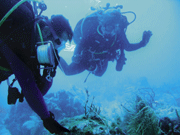'We have an interplanetary Internet running now,' says Adrian J. Hooke, lead researcher at NASA's Jet Propulsion Laboratory in Pasadena, Calif.European Space Agency orbiters circling Mars can talk with NASA orbiters and with landing vehicles on the red planet, and all of them can communicate with Earth ground stations using a common set of protocols.The network so far is rudimentary. Hooke compares it to the early Internet around 1970, when only a handful of machines could communicate.Teams of scientists from space agencies, the military and universities around the world are trying to extend the limits of communication in deep water as well as deep space.In October, U.S. and Canadian astronauts will spend 10 days in an underwater habitat testing remote surgical techniques over a medical-grade network.'It gives us an opportunity to evaluate how technologies might work in a similar operational environment in space,' said Canadian astronaut Dr. Dave Williams, who heads the NASA Extreme Environment Mission Operations, or NEEMO.Dr. Mehran Anvari will be at one end of the network in Hamilton, Ontario, while remotely operating a medical robot in the Aquarius underwater habitat off Key Largo, Fla.The procedure will use an abdominal surgical simulator rather than a live patient, but Anvari and the robot already have performed more than 20 real remote operations.NASA hopes the effort will pave the way for remote medical care for International Space Station crews and deep space explorers.Anvari has operated on patients up to 250 miles north of the Center for Minimal Access Surgery in Hamilton. A multiprotocol-label-switching network supplied by Bell Canada links the sites.The network has three classes of commercial service. The top grade, Real Time, is for voice and streaming media, but a new class called Surgical Grade will serve the remote medical operations to ensure reliability at every router hop.Each end will have a Cisco Pix firewall, a pair of Catalyst 2955 switches and a 3700-series router from Cisco Systems Inc. of San Jose, Calif.'There is a noticeable, subsecond latency' in the network, said Brantz Myers, Cisco's national enterprise marketing manager in Toronto. That has not posed a problem for Anvari, however, who 'says it is amazing how quickly you adjust,' Myers said.The October mission will be the seventh underwater NEEMO mission, funded by the National Oceanic and Atmospheric Administration and operated by the University of North Carolina at Wilmington.Aquarius is about the same size as the International Space Station's living quarters. It rests 62 feet underwater about three miles from Key Largo.Having astronauts work in this extreme environment adds realism impossible in a simulator, NEEMO project manager William L. Todd said.'This is a real mission, in a real extreme environment, with real consequences to your actions.'Because the astronauts' environment is pressurized at 2.5 atmospheres, the dissolved nitrogen in their blood requires 15 hours of decompression before they can return to the surface.'There are differences and similarities' between space and Aquarius, Williams said. The underwater habitat has gravity, but overall, 'living and working in Aquarius is very much like living and working in space.'The last NEEMO mission tested astronauts' ability to network wirelessly in a cramped environment with lots of metal bulkheads.'We want to go to wireless inside the space station,' Todd said. 'It isn't so much the hardware, it's the way it is set up.'Another IT peculiarity underwater is that 'at 2.5 atmospheres, computers don't behave as they should,' he said. 'We have a 50 percent failure rate on hard drives.'Another challenge is bandwidth. There is a 45-Mbps wireless bridge between the ground station ashore and the buoy that provides power and communications to Aquarius.'Because of the waves, the antenna doesn't always point in the same direction, so we have to come up with a very robust system that will maintain the telemetry,' Todd said.The huge distances involved and the intermittent availability of links are other pitfalls of deep-space communications. NASA has been struggling with them for more than 40 years, JPL's Hooke said.'I worked on the telemetry systems of the Apollo lunar module,' he said. Each mission essentially built its own communications system. By the early 1970s, he said, 'I got tired of having to reinvent the data systems over and over.'The result of his frustration was standardized protocols. As the Internet moved to packetized transmission, which became TCP/IP, 'we came up with the same notion,' which became packet telemetry, Hooke said.Packet telemetry is the standard for NASA's Goddard Space Flight Center and JPL, and eventually for the rest of NASA and the European Space Agency. In 1982, the world's 10 major space agencies formed the Consultative Committee for Space Data Systems to agree on common interfaces for sharing information and communicating with ground stations.The first protocols specified point-to-point links between a spacecraft and the ground and between two spacecraft. The current Messenger mission to Mercury is the first to use CCSDS' File Delivery Protocol, which also does some routing.'We recognized the need to move into an era where we would be file-based,' Hooke said. 'The routing is fairly simple because we have fairly static mission configurations.'Mission data from 20 or 30 instruments always goes to the same 20 or 30 ground locations. But as more missions begin intercommunicating, routing will have to become more dynamic.CCSDS now is working on a long-haul version of TCP/IP for the Interplanetary Internet. Vinton Cerf of MCI Inc., often called the father of the Internet, is devoting part of his time to JPL's work on communications in an inherently disconnected environment.The Defense Advanced Research Projects Agency, which built the original Internet, is funding some of the research for its Disruption-Tolerant Networking program. As DARPA's technology matures, it will be reapplied to the space program, Hooke said.One significant difference between the Interplanetary Internet and its earthly counterpart is that security is being designed in from the beginning to keep the wrong people out, Hooke said.Maybe that will mean no spam in space.
NASA is testing a medical network under water as part of efforts toward providing remote medical care in space.
Courtesy of NASA







